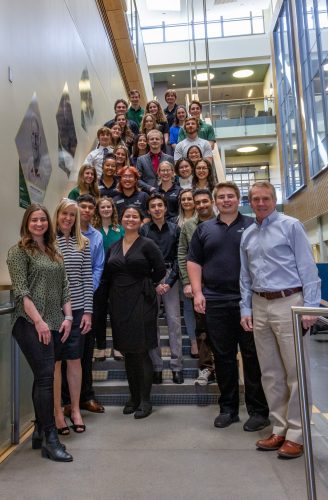The Scott Undergraduate Research Experience (SURE) pairs Scott Scholars and first generation engineering students with faculty researchers to provide a unique research experience to undergraduates not commonly found at large universities.

Identifying a true research experience as a first or second year student, let alone a paid opportunity, can be very difficult. SURE helps students and faculty make connections, resulting in exciting and educational research opportunities for students.
Benefits of participating in SURE:
- Learning how classroom work applies to real world issues
- Mentoring by faculty and graduate students
- Getting paid to do engineering work
- Learning about direct engineering applications
Donor Support
The SURE program is made possible by support from alumni and donors. Visit our Alumni & Giving page if you are interested in supporting this program.
Key program details
Each fall, all first and second year Scott Scholars and first generation students will receive email inviting them to apply for the SURE program, so be sure to watch your @colostate.edu email account!
A matching fair is held so eligible students can meet with faculty to understand the research opportunities available.
Any student who believes they are eligible for SURE but does not receive an email invitation should contact Susan Benzel.
Students and faculty mentors will be matched in the fall, and research work will start in the spring semester.
Our goal is to match all students who apply to SURE with a research opportunity.
If we have more than 45-50 students apply, some students may not be placed. Susan will work with any students not placed to find other potential research options.
SURE culminates with a poster fair and celebration at the end of the spring semester
SURE program results to date
2019 Survey
Based on your experience in the SURE program, are you better able to see yourself as an engineer?
n/a for 2019
Percentage of students who feel the SURE program helped them clarify what they want to do after graduation
Yes 71%
Percentage of students who have strengthened their desire to pursue an engineering degree as a result of participating in the SURE program
Yes 90%
Percentage of students who feel more connected with the Walter Scott, Jr. College of Engineering after participating in SURE
Yes 95%
Percentage of students who plan to continue to work with their SURE faculty sponsor after the SURE program ends
Yes 76%
Percentage of students who will be more likely to request mentoring from their faculty sponsor in the future
Yes 86%
Percentage of students who would recommend SURE to their fellow students
Yes 100%
Percentage of faculty/GRAs who are interested in participating in the SURE program in the future
Yes 100%
2021 Survey
Based on your experience in the SURE program, are you better able to see yourself as an engineer?
Yes 100%
Percentage of students who feel the SURE program helped them clarify what they want to do after graduation
Yes 87%
Percentage of students who have strengthened their desire to pursue an engineering degree as a result of participating in the SURE program
Yes 93%
Percentage of students who feel more connected with the Walter Scott, Jr. College of Engineering after participating in SURE
Yes 97%
Percentage of students who plan to continue to work with their SURE faculty sponsor after the SURE program ends
Yes 50%
Percentage of students who will be more likely to request mentoring from their faculty sponsor in the future
Yes 87%
Percentage of students who would recommend SURE to their fellow students
Yes 100%
Percentage of faculty/GRAs who are interested in participating in the SURE program in the future
Yes 100%
Cumulative
Based on your experience in the SURE program, are you better able to see yourself as an engineer?
Yes 100%
Percentage of students who feel the SURE program helped them clarify what they want to do after graduation
Yes 80%
Percentage of students who have strengthened their desire to pursue an engineering degree as a result of participating in the SURE program
Yes 92%
Percentage of students who feel more connected with the Walter Scott, Jr. College of Engineering after participating in SURE
Yes 96%
Percentage of students who plan to continue to work with their SURE faculty sponsor after the SURE program ends
Yes 61%
Percentage of students who will be more likely to request mentoring from their faculty sponsor in the future
Yes 86%
Percentage of students who would recommend SURE to their fellow students
Yes 100%
Percentage of faculty/GRAs who are interested in participating in the SURE program in the future
Yes 100%
Note: Due to the COVID-19 Pandemic and university response, the survey was not offered in 2020.